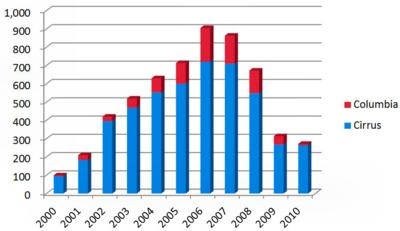What Led To The Current State Of Their Media Relations?
Analysis/Opinion By Rich Belzer
ANN E-I-C Note: Our recent stories
concerning our experiences in attempting to cover the issues
involved with Cirrus Aircraft have produced quite a bit of
information... as well as shaking loose a number of persons who,
heretofore, were unwilling to speak out. The amount of info that
has resulted has been illuminating as well as disappointing in that
we have learned that things were even worse than we believed.
Regardless; we have also received some interesting insights and
reports as to not only what happened to Cirrus... but what its
future might hold. In particular, Rich Belzer's analysis is
intriguing... and while we do not necessarily agree with each of
his conclusions or the associated analysis, his is an educated
viewpoint that deserves airing... let us know what you think.
-- Jim Campbell -- ANN E-I-C
So... Who Drove this Airplane Company Into The
Ditch?

I have read with interest Jim Campbell's recent articles on his
current difficulties with Cirrus Aircraft. Having competed
head-to-head with Cirrus for years while at Columbia Aircraft, I
grew to learn a great deal about this company and, without
question, to envy their success.
In addition, given my rather lengthy business career of 43
years, much of it in senior executive positions outside of
aviation, I have followed with great interest the successes and
failures within the general aviation (GA) business.
Over the first decade of the 21st century, no company has had a
greater impact on GA than Cirrus. Yes, both Cirrus and Columbia
created a new market segment, bringing out high-performance
composite (fiberglass) aircraft which achieved speeds in excess of
200 knots and did so with their gear fixed.
But, although the products from each company were quite similar,
it was Cirrus that drove the market as the following delivery
numbers from GAMA demonstrate:

Over these 11 years, Cirrus dominated its competition with
Columbia (and now Cessna) by a resounding 85% to 15%. (From 2008
on, the Columbia 350 and 400 were manufactured and sold by Cessna
as the Corvalis line.)
So were the SR22 and SR22T that much better aircraft than their
counterparts from Columbia or were there other factors at work that
produced such lopsided results?
During my years at Columbia Aircraft, I put in quite a bit of
effort attempting to answer the above question. I flew the SR22
and, of course, have many hours in the Columbia 350 and 400; I
spoke with owners of both aircraft; I got to know people in the
Cirrus management team.
From my perspective, the aircraft each had their unique
advantages. The Cirrus aircraft had parachutes; the Columbia's had
a high-level of structural integrity which allowed them to be
certified in Utility Category (and permitted Sean D. Tucker to fly
aerobatic routines in a Columbia 400). While the parachute does
provide some peace of mind, most owners will never use it; the
solidity of the Columbia's was there for the pilot every time he
flew. High-hour pilots who had experience flying both company's
aircraft almost always preferred the Columbia's handling
characteristics. The Cirrus airplanes have more room in the back
seat - both legroom and headroom; the Columbia's sacrificed some
interior room for a slicker design and less drag. In a fuel-burn
analysis based upon POH numbers for the SR22 and Columbia 350 (both
equipped with the Continental IO-550), at any given cruise speed
and at any altitude, the 350 always burned less fuel (by 10% to
20%) than the SR22. The bottom line is that while the Cirrus
aircraft do have features of value to many customers (the parachute
and more interior room), the Columbia's had sufficient offsetting
capabilities to make this competition closer than the results.
So... why was Cirrus so dominant?
The answer to that question is a name you have probably never
heard before - John Bingham. When Crescent Capital (now Arcapita),
became the primary investor in Cirrus, they left Alan Klapmeier in
place as CEO but brought in other senior executives to strengthen
the company's management team. Bingham, a former Rolls Royce
executive, joined Cirrus in 2002 to run sales and marketing; in
2001, the company had delivered 210 airplanes; largely through his
expertise, Cirrus grew to over 700 aircraft per year prior to the
recent recession. Following his departure to head up Piaggio
America, Cirrus never upgraded its talent in sales/marketing
management to Bingham's level and it shows.
John Bingham

I should add that Columbia Aircraft, by contrast, placed little
emphasis on strong sales and marketing management. When I joined
the company early in 2004, it had the most dysfunctional
distribution organization I had ever encountered in my 35 years in
sales/marketing and the executive running this group had never
before held a position in either sales or marketing. Even when the
company went outside to bring in a sales and marketing vice
president, the individual they hired had never run a distribution
organization. To be blunt, John Bingham killed us and made that
85%/15% market split happen; by the time I was granted control of
worldwide sales at Columbia in late 2006, the company was broke and
would file for bankruptcy within 12 months.
Cirrus always had a great relationship with the media. Alan
Klapmeier was a natural at dealing with the press and John Bingham
was skilled and experienced as well. So how did this company end up
so crosswise with one of the most influential members of the
aviation media - Jim Campbell of Aero-News Network (ANN)?
Obviously, the absence of Alan Klapmeier hurt but was compounded
by the fact that Bingham had departed as well. Why was Klapmeier
tossed out of the company he had founded? My sense is that his
reaction to the recession lacked the urgency that the company's
board of directors (essentially Arcapita) was looking for.
I doubt that Klapmeier had ever before run a company where sales
dropped as quickly as what occurred over a three year period at
Cirrus:
Cirrus Deliveries
|
2007
|
2008
|
2009
|
710
|
549
|
268
|
That is a 62% drop in just two years! As a CEO, how do you cope
with such a precipitous decline, especially at an airplane company
where overhead runs high? First you put a stop to any non-essential
programs - at Cirrus, this meant that Klapmeier's pet project, the
Jet, needed to be put on hold. Secondly, you lay off any personnel
that you don't absolutely have to have to keep the company
operating. For Klapmeier, actions such as these had to look like
the destruction of his company and, I am sure, many who needed to
depart were like family to him.
Chief Financial Officer (CFO) Brent Wouters, like Bingham
brought in by Arcapita, had to be pushing for rapid austerity
measures and must have had the ear of the board. Under these
circumstances, any resistance by Klapmeier would have put him at
odds with Arcapita and probably led to his departure. Rather than
bring in a new CEO, Arcapita awarded the job to Wouters, a highly
experienced CFO but with no prior experience running an airplane
company. While Wouters understood the financial necessities of
getting the company as close to a break-even cash flow as possible,
he had little of the interdisciplinary background needed to
effectively lead the company. In addition, he lacked experience in
dealing with the media and was not a known aviation enthusiast like
Alan Klapmeier. If Bingham had still been around, this might not
have been a big problem; with both Klapmeier and Bingham gone, the
company was left sorely lacking in the public relations (PR)
area.
So here was a company struggling to stay afloat and taking many
of the actions that companies are forced into in troubled times.
Personnel were laid off, development of the Jet ceased, payables to
vendors were delayed and negotiations were initiated with potential
investors who might buy out Arcapita and bring additional cash to
the company. Under such circumstances, maintaining an excellent
relationship with the media is critical in order to minimize public
damage to the brand. In aviation, there are only a few key
magazines and Web sites to deal with but they have enormous
influence within the pilot community and among potential aircraft
buyers.

In business, being an amateur in a specific discipline is only a
problem when you don't know enough to understand you need help.
Brent Wouters perhaps figured he could save money by handling the
press on his own; how tough could that be? You don't have to read
ANN for long to figure out how well that strategy worked.
So Wouters is now gone; my information is that it was his own
decision based upon differences with the company's Chinese owners,
CAIGA, a division of AVIC, itself a wholly-owned subsidiary of the
Chinese government. But who really cares why he departed? Wouters
is gone and the company is now being directly run by its Chinese
masters with Dale Klapmeier on hand as a figurehead. Is this a good
thing?
Personally, I believe that things are about to get worse. I have
dealt with government-owned Chinese companies in the past and they
have great skills in certain areas - production, for instance. From
a sales-marketing-PR perspective, especially outside their own
country, they know next to nothing. So don't expect Cirrus to ever
again be the sales/marketing force they were when John Bingham was
around.
Cirrus will be an interesting company to watch, though. My
prediction is that, over time, all of their composite parts will be
manufactured in China. In addition, it would not surprise me if,
within five years, they are making more aircraft in China than in
the U.S. And what about the Jet? Personally, it never made sense to
me (and neither does the D-Jet). One could easily design a
composite 6-seat turboprop which would sell for the same price,
cruise at the same speed and burn one-half the fuel. The simple
fact is that small jet engines are inefficient and CAIGA knows
this. After all, they are already fooling around with the Epic LT
experimental turboprop for which they acquired the intellectual
property rights. AVIC may know little about sales and marketing but
they are not stupid when it comes to airplanes; they are, after
all, the world's largest aviation company with revenue in the
vicinity of $1 trillion.

As for ANN, I hope they are able to finally squeeze out the
money owed them by Cirrus. I wouldn't hold my breath but a lawsuit
might eventually produce the desired effect.
About Rich Belzer: Rich has
been a pilot for 25 years as well as an aircraft owner, holding a
commercial license with an instrument rating. Following 35 years in
the computer industry, ten in senior executive positions, he joined
Columbia Aircraft in 2004 as national sales manager. While at
Columbia, he established all of the company's international
distribution and eventually was granted full responsibility for
worldwide distribution as the company's sales vice president. He
has been interviewed numerous times by written and broadcast media
on aviation business issues and written a number of articles for
Aero-News Network.
FMI: A 'Few' Stories From The Decline Of The Cirrus
Empire:
-
No Good Deed Ever Goes Unpunished: Taking On The Cirrus
Fiasco, Part 2
-
No Good Deed Ever Goes Unpunished: Taking On The Cirrus
Fiasco, Part 1
-
Cirrus Is Again Behind On Its Rent In Grand
Forks
-
The Other Shoe Drops At Cirrus: Wouters Gone, Dale
Klapmeier Now CEO
-
Cirrus Owner's Group Continues To Bow, In Part, To
Cirrus/China's Demands
-
Bizarre: Chinese-Owned Cirrus Attempts To Dictate Media
Coverage of Cirrus Event
-
Cirrus Chinese Connection Draws Attention
-
CAIGA Assures Duluth (In Writing) That Cirrus Will Be
Staying Put
-
Alan Klapmeier Will Design Kestrel In
Duluth
-
It's Done! Cirrus Merger With CAIGA
Closed
-
Rise and Fall: The Fortunes/Misfortunes Of The Cirrus Dream
(Part 3 Of A Series)
-
Rise and Fall: The Fortunes/Misfortunes Of The Cirrus Dream
(Part 2 Of A Series)
-
Rise and Fall: The Fortunes/Misfortunes Of The Cirrus Dream
(Part 1 Of A Series)
-
It's Time To Choose: If You Stand For Nothing, You'll Fall
For Anything…
-
Cirrus Lease Arrears In Grand Forks, ND Reported To Top
$1.7 Million
-
Investors Waiting On Cirrus Counter-Offer
-
Congressman Cravaack Urges Caution In Cirrus Deal With
China
-
American Effort Underway to Head Off Chinese Sale of
Cirrus
-
Cirrus/CAIGA Merger Deal Reportedly Valued At '$210
Million' -- Maybe
-
What Is Behind China's Recent GA Buying
Spree?
-
Wouters Says Cirrus Jobs Will Stay In Duluth, Grand
Forks
-
Updated: Concerns Grow Over Much-Delayed/Hyped Cirrus Jet
Program
-
As Predicted... Cirrus 'Merges' With China's
CAIGA
-
Cirrus Denies Reports of Sale To China
-
Aero-TV: Something Old, Something New -- The Launch of
Kestrel Aircraft
-
Kestrel Turboprop Program Back On Track... With Alan
Klapmeier As CEO!
-
Cirrus Drops L-3 Lawsuit
-
Cirrus Fights Rumors
-
Cirrus Looks For Tax Break From St. Louis County,
MN
-
Cirrus Hopes To Restructure Lease In Grand Forks,
ND
-
Alan Klapmeier Clears Out Office At Cirrus
Aircraft
-
Cirrus Jet Sale At An Impasse?
-
Cirrus Notifying SRS Deposit Holders Of Temporary Program
Suspension
-
Another Round Of Layoffs At Cirrus
Aircraft
-
Cirrus Says Production Cutbacks Imminent
 Aero-News: Quote of the Day (04.28.25)
Aero-News: Quote of the Day (04.28.25) ANN's Daily Aero-Term (04.28.25): Decision Altitude (DA)
ANN's Daily Aero-Term (04.28.25): Decision Altitude (DA) ANN's Daily Aero-Linx (04.28.25)
ANN's Daily Aero-Linx (04.28.25) Airborne-Flight Training 04.24.25: GA Refocused, Seminole/Epic, WestJet v TFWP
Airborne-Flight Training 04.24.25: GA Refocused, Seminole/Epic, WestJet v TFWP Aero-News: Quote of the Day (04.29.25)
Aero-News: Quote of the Day (04.29.25)







